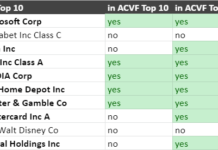Alternative Energy and Climate Change Mutual Funds, Part V
Tom Konrad, CFA
Actively managed clean energy funds have been producing better returns than index funds, despite much higher expenses.
I’ve long been critical of the costs of Alternative Energy mutual funds, but I now regret that stance.
Past Performance of Mutual Funds
When I recently surveyed the performance of Alternative Energy mutual funds, I found the results were pretty good, at least in comparison to the oldest sector index fund, the Powershares Clean Energy Index (PBW). See the following chart below, which shows the amount you would have had to invest in each of the alternative energy mutual funds at the start of any given year, in order to have $1,000 at the end of October 2010. Lower values are better, so the lines at the bottom of the chart are the best performing mutual funds.

Note that the orange line, for the Powershares ETF, has performed worse than almost every mutual fund over three or more years. A couple of the mutual funds performed worse than PBW over the last one or two years, but the shorter the time period in question, the more likely the result is to have been the result of luck than management skill.
Past Performance of ETFs
One possibility is that the apparent superiority of actively managed mutual funds is not the result of the mutual funds being superior, but because I might have chosen an inferior ETF. In order to check, I performed a similar study on the broad Alternative Energy Sector ETFs:

As you can see, PBW is the second-worst performing ETF since the start of 2008, although it has performed a little better over the last two years, so some of the mutual funds’ apparent out performance is due to my selection of PBW as a benchmark.
But not all. As you can see from the table below, the average clean energy mutual fund has outperformed the average clean energy ETF by 17% over the last 3 years (which is the entire track record for a majority of the existing funds and ETFs.) Furthermore, the best mutual fund beat the best ETF by a whopping 52%, and even the worst performing mutual fund beat the worst performing ETF by 3%, so the actively managed mutual funds beat the passively managed ETFs across the board.
| Performance Jan ’08 to 11/14/10 | Worst | Average | Best |
| Mutual Funds | -63% (GAAEX) | -37% | 21% (SRICX) |
| ETFs | -66% (GEX) | -54% | -31% (PZD) |
| 10 Stocks for 2008, ’09, and ’10. | -32% | ||
Despite the fact that we only have three years of data, I’m now fairly confident that most investors would be better off choosing one of the clean energy mutual funds than they would be choosing one of the ETFs. Which mutual fund should you pick? That’s the topic of this series of articles on Alternative Energy and Climate Change Mutual Funds. So far, I have looked at mutual fund costs (part I), portfolio composition (part II) and past performance (part III).
Stocks Are Still Best
I’ve also picked out some interesting individual stocks from the mutual fund portfolios (part IV). That is because, while I’ve reversed my former position and now think an actively managed mutual fund is better than a passively managed ETF, I’ve always said that an actively managed clean energy stock portfolio is the best of all worlds.
An actively managed stock portfolio can be managed at lower cost than the sector ETFs, and much lower cost than the sector mutual funds. It’s also not particularly hard to build such an actively managed stock portfolio. One approach is cherry-picking stocks from the portfolios of the mutual funds themselves, as I did in part IV of this series. I tried a similar experiment in 2009 which I called a Quick Clean Energy Tracking Portfolio, and the resulting portfolio strongly outperformed the mutual funds it was built from, although that turned out to mostly due to my selection of high-Beta stocks for the portfolio.
Another easy way to build an actively managed stock portfolio is to use my annual “Ten Clean Energy Stocks” list, which I’ve been publishing at the start of the year since 2008. While this is not a truly actively managed portfolio since it only trades once per year, the performance has been better than the vast majority of the mutual funds and ETFs, having lost only 32% since the start of 2008, while the average mutual fund lost 37%, and the average ETF lost 54%. See the table above.
If you have the time and interest, you can manage a stock portfolio. That’s always been my favorite option, since I do it myself, but it’s also practically a full-time job, at least if you want to do it well.
One last option is to use an investm
ent advisor who will manage a portfolio of clean energy stocks for you. So far, I know of three, although not all of them will take small accounts. Use the contact link to send me an email if you’d like a referral. You may also want to read what I have to say about selecting an advisor here.
If you are an advisor who manages green individual stock portfolios for your clients, let me know and I’ll add you to my list.
DISCLOSURE: No Positions. GAAEX is an advertiser on AltEnergyStocks.com.
DISCLAIMER: The information and trades provided here are for informational purposes only and are not a solicitation to buy or sell any of these securities. Investing involves substantial risk and you should evaluate your own risk levels before you make any investment. Past results are not an indication of future performance. Please take the time to read the full disclaimer here.








